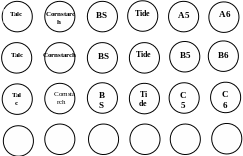GENDER IDENTITY SALIENCE AND PERCEIVED VULNERABILITY TO BREAST CANCER
0618 NAME MARGARIDA MARIA TERESA JUSTA COLL PADRESA GENDER0687 NAME MARIA DEL CARMEN CATALINA FRANCISCA PADRES GENDER
0867 NAME CATHERINA GERTRUDIS ROSA PADRES GENDER FEMALE BAPTISMCHRISTENING
10 THINGS MEN CAN DO TO PREVENT GENDER VIOLENCE
1511 GENDER EQUALITY ACT NICHT LÖSCHEN BITTE
2 AUGUST 2007 STRENGTHENING GENDER EQUALITY PROGRAMMING IN HUMANITARIAN
GENDER IDENTITY SALIENCE AND PERCEIVED VULNERABILITY
GENDER IDENTITY SALIENCE AND PERCEIVED VULNERABILITY
TO BREAST
CANCER
STEVEN SWELDENS
Rotterdam School of Management, Erasmus University
STEFANO PUNTONI
Rotterdam School of Management, Erasmus University
NADER TAVASSOLI*
London Business School
*Steven Sweldens is a Ph. D. candidate in Marketing and Stefano Puntoni is Assistant Professor of Marketing at the Rotterdam School of Management, Erasmus University, P.O. Box 1738, 3000 DR Rotterdam ([email protected], [email protected]). Nader Tavassoli is Professor of Marketing, Chair Marketing Subject Area, London Business School, Regent’s Park, London NW1 4SA UK ([email protected]).
Abstract
Contrary to predictions based on cognitive accessibility, heightened gender identity salience resulted in lower perceived vulnerability and reduced donation behavior to identity-specific risks (e.g., breast cancer). No such effect was manifest with identity-neutral risks. Establishing the importance of self-identity, perceived breast cancer vulnerability was lower when women were primed with their own gender, but not with the general category of gender. Establishing the involvement of unconscious defense mechanisms, fear appraisal prior to the risk rating task eliminated the effect of a gender identity prime on perceived breast cancer vulnerability. The findings have direct implications for health communication and donation campaigns.
Extended Abstract
Breast cancer is one of the world’s leading causes of death and breast cancer awareness campaigns aim to increase women’s risk awareness and promote early screening behavior. Health campaigns aimed at increasing women’s breast cancer awareness often stress women’s vulnerability to breast cancer using images and appeals related to the female sex and to femininity. Estimates of personal risk are constructed by individuals based on environmental cues and personal experience. In particular, personal risk perceptions are closely tied to individuals’ sense of self due to the link between aspects of one’s self-concept (e.g., lifestyle, age or gender) and actual risk. Despite the large body of literature devoted to understanding the psychological processes involved in the estimation of perceived vulnerability, the relationship between risk estimates and self-identity is still unclear.
This paper explored how inherent characteristics of a risk interact with self-identity salience to influence estimates of perceived vulnerability. In particular, we investigated how and under which conditions the salience of a certain identity trait (e.g., gender) can influence one’s perceived susceptibility to risks associated with this trait (e.g., breast cancer). Two alternative theoretical accounts—cognitive accessibility and defense mechanisms—provide opposing predictions with regard to the direction of the influence of identity salience in perceived risk.
Cognitive accessibility predicts an increase in gender-related risk perception following an increase in gender salience. Contextual factors that increase the salience of a dimension of self-identity should increase the accessibility of knowledge structures associated with this dimension and result in higher likelihood estimates for risks that are associated to this activated dimension through the operation of judgmental heuristics. For example, increased (decreased) accessibility of AIDS-related information had a positive (negative) effect on associated risk perceptions (Raghubir and Menon 1998). The cognitive accessibility account therefore predicts that increased gender salience should increase estimates of gender-specific risks.
A different line of reasoning, based on defense mechanisms, leads to the opposite prediction for identity aspects that are central to the self. The sexual self is a central aspect of women’s multifaceted self and a disease such as breast cancer is inextricably bound to women’s perception of their gender identity. Under conditions of heightened gender identity salience, the thought of contracting breast cancer may be perceived as especially threatening. Consequently, defensive mechanisms—which are intimately related to ego threat—may occur in these conditions, leading to a minimization of subjective risk estimates. For example, participants who were made to believe they suffered from a fictitious enzyme deficiency evaluated this deficiency as less serious than controls (Jemmott, Ditto, and Croyle 1986) and personal relevance increases the likelihood that threatening health messages are defensively processed (Liberman and Chaiken 1992).
To summarize, two distinct accounts make opposing predictions regarding the effect of identity salience on identity-specific risk perception. Cognitive accessibility predicts that heightening women’s gender identity increases perceived vulnerability to risks such as breast cancer. A motivational defense mechanism account predicts instead that when a central aspect of the self (e.g., women’s gender) is made more salient, threats (e.g., breast cancer) to this aspect are likely to trigger defensive mechanisms (e.g., risk minimization). Neither account predicts an effect of increased gender salience on gender-neutral risks.
We conducted a series of experiments with female participants to test these theories. Significant interactions and simple effects provide evidence for the defensive mechanism account and explored boundary conditions for the effect of identity salience on perceived risk. In experiment 1, 2, and 4 identity salience was manipulated using an essay writing task. Relative to a control condition, in the gender prime condition we observed a decrease in women’s perceived risk of contracting breast cancer (experiments 1 and 4) whereas no effect was evident on risks without a link to gender identity. Behavioral implications were apparent in experiment 2, in which we found that gender priming leads to a decrease in donations to research on ovarian cancer treatment. Confirming the role of nonconscious defensive mechanisms, fear appraisal prior to the risk rating task muted the effect of gender identity salience on risk perceptions (experiment 4). In experiment 3 we used a more subtle gender priming task in which participants determined the gender of Dutch words. Establishing the importance of self-identity, perceived breast cancer vulnerability was lower when women were primed with their own gender, but not with the general category of gender.
These experiments contribute to literature on subjective risk estimates, defensive mechanisms and cognitive priming. Moreover, the results have implications for the design of health campaigns. Breast cancer awareness campaigns almost inevitably stress womanhood or women’s sense of gender identity and along with it the relative importance of this identity aspect for their self-concept. Our findings indicate that an increase in gender identity salience can trigger defensive mechanisms of risk minimization, thus potentially attenuating or even reversing a campaign’s intended consequences. The results of the experiments provide a number of suggestions on how to reduce the likelihood of defensive mechanisms interfering with the intended aim of health campaigns.
Jemmott, John B., Peter H. Ditto, and Robert T. Croyle (1986), "Judging Health Status: Effects of Perceived Prevalence and Personal Relevance," Journal of Personality and Social Psychology, 50 (5), 899-905.
Liberman, Akiva and Shelly Chaiken (1992), "Defensive Processing of Personally Relevant Health Messages," Personality and Social Psychology Bulletin, 18 (December), 669-679.
Raghubir, Priya and Geeta Menon (1998), "AIDS and Me, Never the Twain Shall Meet: The Effects of Information Accessibility on Judgments of Risk and Advertising Effectiveness," Journal of Consumer Research, 25 (June), 52-63.
20 GENDER AND COGNITION SUPPLEMENTS ARCHIVES SPACE GENDER DIFFERENCES
21 C CHISWICK OCCUPATION AND GENDER OCCUPATION AND GENDER
3 ARATÓ LÁSZLÓ BEVEZETŐJE GENDER ÉS HAGYOMÁNY – NŐI
Tags: breast cancer, campaigns. breast, breast, gender, vulnerability, cancer, identity, perceived, salience
- SCHOOL GOVERNANCE LEARNING FROM THE BEST SCHOOL GOVERNING BODIES
- CITY OF HECTOR – HECTOR MUNICIPAL AIRPORT WAITING LIST
- NOMINATION FORM WIDE BAY 1319YRS SCHOOLS SWIMMING TEAM 2021
- UTBETALNING AV STATSBIDRAG FÖR FÖRBÄTTRING AV ENSKILD VÄG 1
- 2021 CLEAR CREEK VOLLEYBALL SATURDAY SCRIMMAGE SCHEDULE 8721 AT
- ANALYSIS ON AND CONVERGENCES OF EAST ASIAN CURRENCIES APRIL
- UNIVERSITY POLICIES AND PROCEDURES 080303 – RESTRICTED ANDOR PROHIBITED
- I SD SCOTLAND CANCER WAITING TIMES GUIDANCE TO NHS
- TEMPLE UNIVERSITY OFFICE OF THE VICE PRESIDENT FOR RESEARCH
- 30 AÑOS DE CEPA CONCURSO INTERNACIONAL DE ENSAYOS CATEGORÍA
- BANCO MUNDIAL PANORAMA DEL IMPACTO AMBIENTAL DE LOS RECIENTES
- AMPARO DIRECTO EN REVISIÓN 20272005 AMPARO DIRECTO EN REVISIÓN
- Spremembe-pravilnika-TujLit-V1-100506
- ¿QUÉ ES LA PSICOLOGÍA? GEORGES CANGUILHEM LA PREGUNTA ¿QUÉ
- MODELING THE CONDUCTIVITY OF NANOTUBE NETWORKS ANDRIY STELMASHCHUK 1
- THE AMERICAN UNIVERSITY IN CAIRO COMPUTER SCIENCE AND ENGINEERING
- PIERWSZE DECYZJE ZANIM ZDECYDUJESZ SIĘ NA ZOSTANIE WOLONTARIUSZEM
- 11 C COMMENT DETERMINER DES QUANTITES DE MATIERE EN
- MAHARASHTRA STATE ELECTRICITY DISTCOLTDMAJOR STORES `A` AURANGABAD CORRECTED LIST
- SOLICITUD DE PERSONAL PUESTO PROGRAMADOR JUNIOR RESPONSABLE DIRECTO UNAI
- GUIÓN GALLO KIRIKO GRUPO ANA NARRADORA HOLA HOY OS
- ………………………………………… (MIEJSCOWOŚĆ I DATA) …………………………………… (IMIĘ I NAZWISKO RODZICA)
- UCHWALA NR X792003 RADY POWIATU W KĘTRZYNIE Z DNIA
- ASSESSMENT RESULTS ACTION PLANNING FOR A HEALTHY WORKFORCE YOUR
- LIBRO DE BUEN AMOR LOS DOS PEREZOSOS COMENTARIO DE
- SEGUIMIENTO CARTA DE SERVICIOS CIA 2019 GESTIÓN TRÁMITES COMPROMISO
- RIM 2012 INSTRUCTIONS FOR COMPARISON MEASUREMENT OF RADON IN
- THIS PAGE SHOULD BE USING THEME ARCTIC WHICH CANNOT
- CREATE AN ACCOUNT IN EIRB (OUR ELECTRONIC SUBMISSION SYSTEM
- CREATED BY THE ST PAUL PUBLIC LIBRARIES ALL ARE
LEI COMPLEMENTAR Nº 453 DE 05 DE AGOSTO DE
KLASA 33501100101 URBROJ 2137010511057 KOPRIVNICA21072010 NA TEMELJU ČLANKA 55
O MEDICAL SERVICES UTSIDE PRACTICE AND OTHER BUSINESS ACTIVITIES
 AEAT DIT SG DE APLICACIONES 202 – SOCIEDADES PAGOS
AEAT DIT SG DE APLICACIONES 202 – SOCIEDADES PAGOS BATAVIA YOUTH BASEBALL TEAM SPONSOR REGISTRATION FORM IN ORDER
BATAVIA YOUTH BASEBALL TEAM SPONSOR REGISTRATION FORM IN ORDER SPITALUL MUNICIPAL “ DR EUGEN NICOARĂ“ REGHIN STR SPITALULUI
SPITALUL MUNICIPAL “ DR EUGEN NICOARĂ“ REGHIN STR SPITALULUIASOCIACIÓN LATINOAMERICANA DE MEDICINA SOCIAL – ALAMES XI CONGRESO
MARK 929 WHAT DOES THE TRANSFIGURATION TEACH US? FEBRUARY
ANNEX A L’ACTA DE RECEPCIÓ DOBRA EDIFICI (RESSENYA SUMÀRIA
 TÍTULO (ESTILO TÍTULO ARIAL NEGRITA 14 PUNTOS CENTRADO
TÍTULO (ESTILO TÍTULO ARIAL NEGRITA 14 PUNTOS CENTRADO K EMENTERIAN RISET TEKNOLOGI DAN PENDIDIKAN TINGGI UNIVERSITAS BRAWIJAYA
K EMENTERIAN RISET TEKNOLOGI DAN PENDIDIKAN TINGGI UNIVERSITAS BRAWIJAYACONTRADICCIÓN DE TESIS 112012 CONTRADICCIÓN DE TESIS 112012 SUSCITADA
RESUMEN TEMA 4 LA EMPRESA Y LA ORGANIZACIÓN DE
ÖZGEÇMİŞ AYSEL ERDOĞAN KİŞİSEL BILGILER DOĞUM YERI VE TARIHI
 DEVELOPING AND DEPLOYING MARKETING AGILITY IN AN EMERGING ECONOMY
DEVELOPING AND DEPLOYING MARKETING AGILITY IN AN EMERGING ECONOMY BİNGÖL ÜNİVERSİTESİ BÖLGESEL KALKINMA ODAKLI MISYON FARKLILAŞMASI VE İHTİSASLAŞMASI
BİNGÖL ÜNİVERSİTESİ BÖLGESEL KALKINMA ODAKLI MISYON FARKLILAŞMASI VE İHTİSASLAŞMASI DOTAZNÍK PREKÁŽOK V OBCHODE VÝVOZ DOVOZ A INVESTÍCIE DOTAZNÍK
DOTAZNÍK PREKÁŽOK V OBCHODE VÝVOZ DOVOZ A INVESTÍCIE DOTAZNÍK SAYFA 1 1 TARIH 23102010 REV
SAYFA 1 1 TARIH 23102010 REV VANDERBILT STUDENT VOLUNTEERS FOR SCIENCE HTTPSTUDENTORGSVANDERBILTEDUVSVS TESTING HOUSEHOLD CHEMICALS
VANDERBILT STUDENT VOLUNTEERS FOR SCIENCE HTTPSTUDENTORGSVANDERBILTEDUVSVS TESTING HOUSEHOLD CHEMICALSSEBASTIÁN ROMÁN LOBATO 1979 NACE EN CASTROTIERRA DE LA